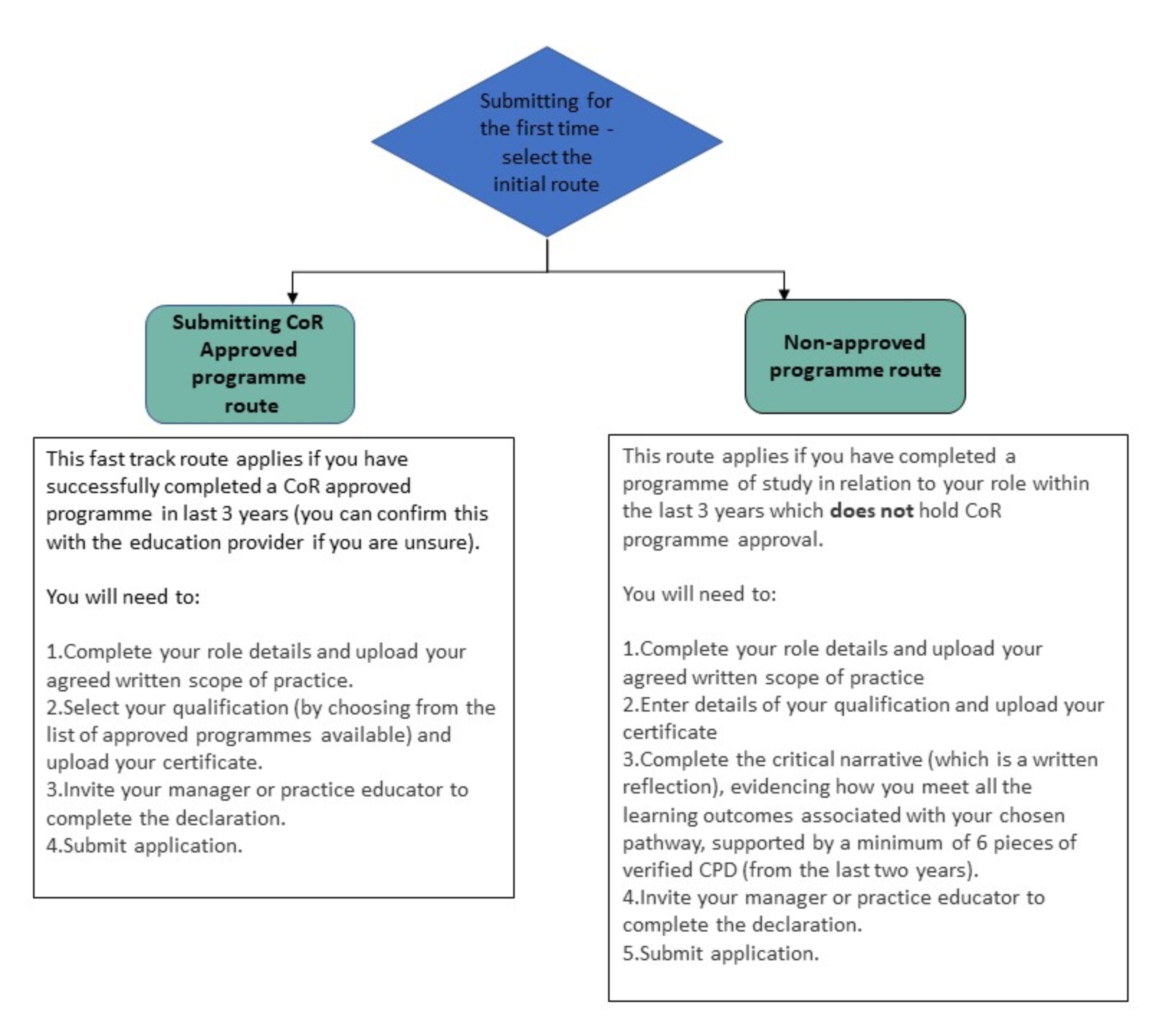
This article presents the rationale for and the process of seeking accreditation or re-accreditation for assistant practitioners and mammography associates working across imaging and radiotherapy services.
It will be of interest to individuals working in these roles or who currently hold College of Radiographers accreditation as an assistant practitioner but also to colleagues and service managers working alongside assistant practitioners and mammography associates.
What is assistant practitioner and mammography associate accreditation?
Assistant practitioners and mammography associates make a significant contribution to service delivery across imaging and radiotherapy departments.
The assistant practitioner and mammography associate accreditation schemes seek to recognise this contribution and aim to promote consistency in the education and development of the support workforce and encourage ongoing engagement with continued professional development through re-accreditation every two years.
The scheme relaunched in 2023 to reflect the evolving scope of practice of members of the support workforce and educational developments, including the updated CoR Education and Career Framework for the Radiography Workforce. The revised scheme also recognises the emergence of the mammography associate as a standalone role.
Based on these updates, there are now three overarching pathways to CoR accreditation:
1. Assistant Practitioner - academic level 4 pathway
2. Assistant Practitioner - academic level 5 pathway
3. Mammography Associate - academic level 4 pathway
Within each of the pathways listed, applicants can apply via one of three routes - a fast-track route if an applicant has completed a College of Radiographers approved programme within the last three years, a non-approved route if holding a non-CoR approved qualification, or a re-accreditation route for those holding CoR accreditation and who are due to re-accredit. To find out more about the academic levels associated with each pathway and how to select the correct pathway, watch this short introductory presentation.
Once awarded, accreditation lasts for two years, at which time re-accreditation is required to ensure that the benefits of the scheme remain in place for individuals. There is no accreditation fee for members of the Society of Radiographers as accreditation, CPD Now and support through the accreditation process are provided as free membership benefits. Non-members should contact our membership team for further details.
Why should I seek accreditation or re-accreditation?
By engaging with the schemes applicants can outwardly demonstrate that they have met the professional body’s expectations associated for their level of practice. This includes eligibility for inclusion on the SCoR’s Public Voluntary Register of Accredited Assistant Practitioners (PVRAAP).
The PVRAAP, along with the accreditation process, have been developed to ensure that those engaged in clinical imaging or radiotherapy at this level of practice have been appropriately educated and trained for their role and are engaging in continued professional development relevant to their role. It therefore provides an outward way for successful applicants to be recognised for the qualifications, knowledge, experience and skills held.
The scheme encourages ongoing engagement with CPD through re-accreditation every two years. It therefore provides assurance to the public and employers that accredited members of the scheme are continuing to engage in CPD activities which are appropriate to the individual’s role and are of benefit to service users and/or service delivery.
Successful applicants who are members of the Society of Radiographers are also eligible for cover of their accredited scope of practice under the SoR Professional Indemnity Insurance Scheme. It is the responsibility of the accredited member to seek re-accreditation should there be any change to their written agreed scope of practice against which accreditation was previously awarded by the CoR.
Collectively engagement with the schemes serves to promote continuity within education and training of assistant practitioners and mammography associates, promote good practice, and ongoing quality and development in practice.
✓ Recognising your contributions to imaging and radiotherapy services
✓ An outward sign of quality
✓ Promotes continuity within education and training
✓ Promotes and supports good practice
✓ Promotes ongoing quality and development in practice
✓ Eligibility to be named on the SCoR Public Voluntary Register of Accredited Assistant Practitioners and Mammography Associates
✓ SoR Professional Indemnity Insurance Scheme (for SoR members)
How do I seek accreditation or re-accreditation?
Applications for CoR accreditation as an assistant practitioner or mammography associate are made through CPD Now - the SCoRs free online CPD platform. Find out more about using CPD Now here.
A summary diagram of the processes for initial accreditation is provided below. Additional
information including a comprehensive applicant guidance document and links to useful resources can be found on the College of Radiographers website.
The process for initial accreditation differs depending on the application route:

Following initial accreditation, assistant practitioner and mammography associate accreditation lasts for two years after which the accredited assistant practitioner/mammography associate will be required to renew their accreditation by applying for re-accreditation. The requirements for re-accreditation follow those of the initial non-approved programme route and must demonstrate further professional development and learning activity since the last accreditation was awarded.
What makes a good critical narrative?
For initial accreditation where an applicant has completed a non-CoR approved programme or for re-accreditation, applicants are required to complete a critical narrative supported by a minimum of six pieces of verified CPD evidence.
The critical narrative should be viewed as the applicant’s professional development ‘story’, where they discuss and reflect on how they have maintained and developed their knowledge and skills to meet the learning outcomes associated with their accreditation pathway.
Throughout the reflection applicants reference the relevant learning outcomes ([AP01] etc) and also link in verified CPD records completed within CPD Now as supporting evidence of their CPD activities in that area. It might help to think of the CPD pieces of evidence as the ingredients list and the critical narrative as the recipe itself.
The CPD pieces should document the what and the narrative explores the why and the how. We have provided a short example below of how this might look as part of an application.
You will also see how the outcomes should be embedded in the critical narrative and how you would include the link to your verified CPD evidence.
Example:
....I have undertaken all the mandatory training components required at my trust for clinical staff who care for patients. Over the two years this has included infection control, handwashing, basic life support (LINK to BLS training session verified CPD), fire safety, moving and handling [AP23]. I have also reviewed the local rules and IRMER regulations as part of my annual update [AP08].
Undertaking this training supports me to care appropriately for patients but also to look after myself and keep myself and others safe in the work environment for example, I understand the legal requirements of duty holders and the importance of correct patient identification.
Undertaking an update around BLS means that whilst I have been fortunate not to be involved in a resuscitation, I have the confidence and training to act when I am required. The purpose of mandatory training is to support the health and safety at work act and through these lifelong learning updates I feel I have the continued confidence to work in a clinical environment in a safe and appropriate way [AP04].
Going forward and after speaking to colleagues at a recent event I will go back to my own department and refresh my understanding of the local procedures in the event of a fire. Such as where are the extinguishers located in my department and which ones do we have – check the colour coding on the labels for example?
The CPD records should be written accounts of specific learning activities, preferably structured using a reflective model such as Gibbs or Rolfe – although we encourage applicants to explore a range of approaches to their reflective practice.
CPD records are required to be verified as being true and accurate by a registered practitioner before they can be linked into the critical narrative. Details on verified CPD can be found within the resource tab in CPD Now.
How is an application assessed?
Once submitted an assessor will review the application to ensure all the required documentation has been provided, check the written and agreed scope of practice correlates to the role that is described by the applicant and to check that the manager declaration is completed.
Where relevant to the accreditation pathway, the critical narrative and verified CPD records will be reviewed to assess the learning and development undertaken by the applicant and how these activities have developed the applicant’s knowledge, skills, and ability to work as an assistant practitioner or mammography associate including the benefit to service users, and to ensure the applicant has evidenced fulfilment of the learning outcomes.
The assessor will also review the application to confirm that the applicant has used a reflective model and included action planning within their CPD pieces.
If any areas are incomplete or the assessor requires more information the applicant will be informed that their application has been deferred. Applicants will be informed of the outcome via auto email and are therefore advised to ensure they keep their contact details updated with the SoR. Please contact [email protected].
There is no limit to how many times an applicant can resubmit, however when seeking re-accreditation applicants should submit with sufficient time in advance of the accreditation expiry date, but no sooner than 12 weeks.
This avoids long gaps between accreditation periods that result in the applicant being temporarily removed from the public voluntary register and a reduction in the member’s level of professional indemnity insurance cover. Further details on accreditation and PII can be found on the CoR assistant practitioner accreditation webpage.
For assistant practitioners that have been awarded accreditation previously and have missed their re-accreditation date, the education and accreditation team will be making contact over the coming months with information to encourage re-accreditation.
The education and accreditation team are here to provide guidance so please get in touch at [email protected].
(Image: Izusek, via GettyImages)
